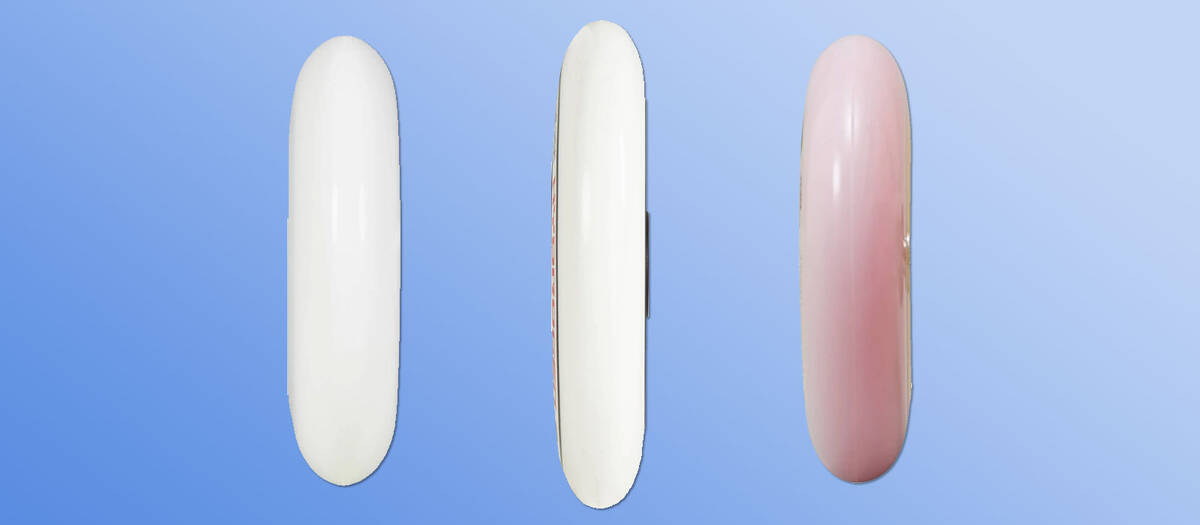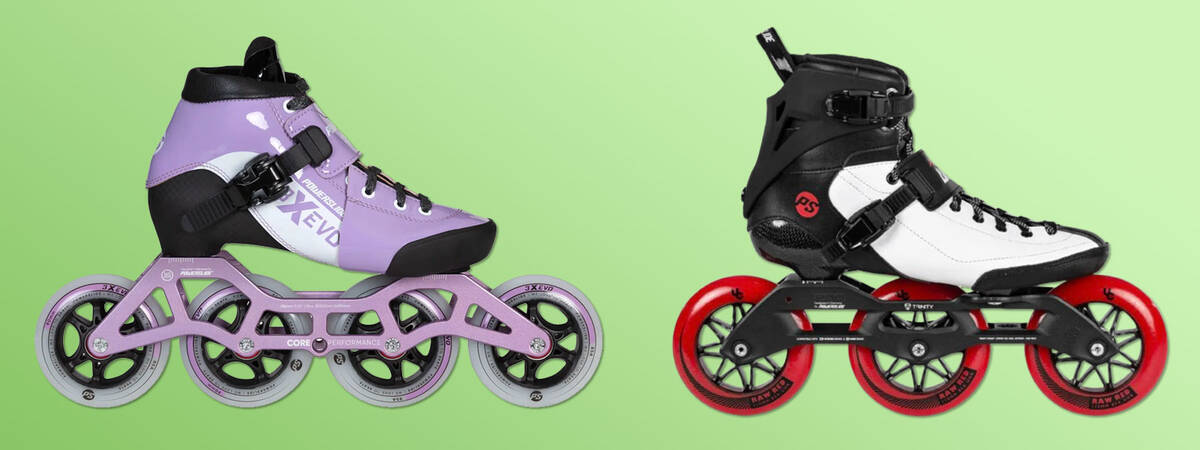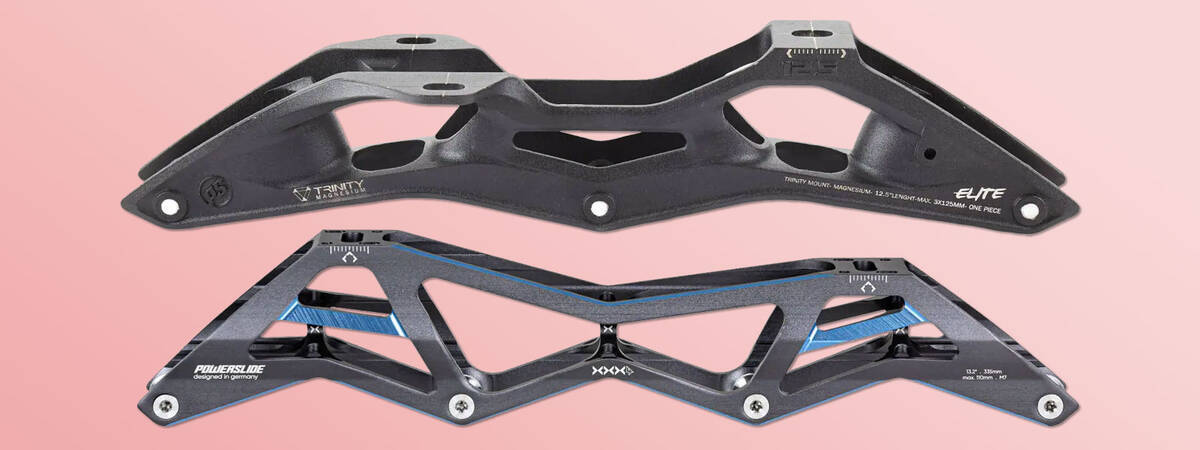Purchasing Speed Skates
This guide is designed to aid you in selecting speed skates, focusing on wheel size, bearings, boots, and frames. Picking the optimum speed skates is integral to performance. Regardless of whether you are a novice or experienced, the essence of speed skates lies in their speed, and within this guide, you’ll discover the elements that enable speed skates to glide swiftly.
Your choices will naturally be influenced by the environment you skate in and the speed skating style you engage in; nevertheless, rest assured, we will clarify the queries you might have regarding picking speed skates.
Optimal Wheels for Speed Skates

For achieving rapid speeds, inline skates need to be equipped with large wheels. Let us delve into the fundamentals of wheels for speed skates. The principal components include wheel size and hardness; however, wheel hubs and profiles also play a role in the performance of your speed skates.
Determining Wheel Size for Speed Skating
Speed skating wheels are generally larger in comparison to recreational skating wheels. Here are some essential tips for selecting speed skate wheel sizes:
- 90 mm: A suitable wheel size for beginners and children, providing a lower centre of gravity for manageable control.
- 100 mm and 110 mm: Ideal for occasional skaters and competitors, enabling higher speeds.
- 125 mm: Preferred by marathon skaters for peak speeds and extended distance coverage. These are used in setups with 3 wheels.
Typically, larger wheels are faster. As a beginner, your technique might not yet be refined for skating with 110 mm or 125 mm wheels, thus you might find smaller wheels to be swifter. Nevertheless, should you possess the skills to manage them, larger wheels allow for higher speeds.
Conversely, smaller wheels accelerate more rapidly. If your primary focus is short-distance sprints, 125 mm wheels should be avoided as they require additional time to reach their potential high speeds.
Note: 125 mm wheels are disallowed in indoor or track races.
Evaluating Wheel Hardness for Speed Skating
The wheels used for speed skating tend to have a higher degree of hardness compared to those for recreational or fitness inline skates. Their hardness reduces surface friction, thereby enhancing speed, but this results in diminished grip and vibration absorption.
When deciding on the wheel hardness for the speed skates you intend to purchase, consider the terrain you will skate on. Are you skating on public roads, outside rinks, or inside rinks?
- Harder wheels: Produce less grip, minimise vibration absorption, lower friction, and allow for faster speeds.
- Softer wheels: Offer increased grip, enhance vibration absorption, increase friction, and achieve higher speeds.
For indoor rinks or smooth surfaces, harder wheels are appropriate. However, for rough or uncertain roads, softer wheels are advisable.
Speed skate wheels often possess a durometer hardness of about 85 A.
Speed Skating Wheel Profile

Typically, speed skating wheels present a narrow or pointed profile. This design reduces the contact area with surfaces, thus decreasing friction and enhancing speed.
As wheels incur wear, the contact point will broaden, shifting the wheels’ centre line outward. This results from the lateral action of your stride and is normal. To prevent adverse effects on your skating, it is recommended to rotate the wheels before they become significantly worn.
Number of Wheels on Speed Skates

Modern inline speed skates typically feature either 3 or 4 wheels per skate, though historically, configurations with 5 wheels were also popular.
- 3 wheels per skate: A shorter wheelbase enhances manoeuvrability and agility. Moreover, 3-wheel skates can accommodate larger wheels, reducing the physical effort to maintain speed. Such skates demand advanced technical skill and are not suggested for absolute novices.
- 4 wheels per skate: With a longer wheelbase, these skates offer increased stability but reduced manoeuvrability. Novices should start with 4 wheels per skate.
In competitive speed scenarios, 3-wheel setups with 125 mm wheels are common in marathons. 4-wheel setups with 110 mm wheels are standard for competitive disciplines conducted indoors or on specialised tracks.
Frames for Inline Speed Skates

Frames in inline speed skates serve to secure the wheels and influence crucial aspects of your setup:
- 3-wheel or 4-wheel frame: This dictates the number of wheels your skates can accommodate.
- Wheelbase: It’s the span between the centres of the front and rear wheel.
- Wheel diameter: What is the maximum wheel size the frame can hold?
Quality frames for inline speed skates are lightweight, typically crafted from aluminium or carbon fibre.
- Carbon fibre frames are noted for their rigidity and lightness, often valued for outstanding power transfer.
- Aluminium frames offer more durability and flexibility compared to carbon frames.
Aligning Inline Speed Skate Frames
Frame alignment is significant for all speed skaters, especially those aiming for top performance. It is vital when opting for new frames or selecting complete speed skates. Personal preferences or unique requirements might entail deviating from the stock frame alignment.
Frame adjustments aim to establish an optimal balance point relative to your physiology. If ankle stability is a challenge (i.e., if you lean inward), a slight lateral adjustment might be necessary.
The adjustment process involves laterally and longitudinally aligning frames with the boots.
Lateral frame adjustment:
- The front wheel should align with the division point between the big toe and the second toe.
- The rear wheel should correspond with the heel’s centre on the boot.
Longitudinal frame adjustment:
- The boot must be central to the frame (ensuring the front boot-to-frame distance matches the back boot-to-frame distance).
Explore our comprehensive selection here:
Boots for Inline Speed Skates

For inline speed skate boots, the key consideration is optimising power transfer, necessitating a stiff and well-fitted boot with no internal foot movement.
Typically absent of liners, speed skate boots might sacrifice comfort for direct power transfer, forming a frequent choice in professional settings. However, many inline skates tailored for speed might still feature comfort elements like heightened ankle support or liners, acting as excellent choices for marathon events.
Heat-Mouldable Boots for Speed Skating
Advanced speed skates often feature heat-mouldable boots, which become shapeable when heated. Heat-moulding aligns the boot to your foot’s profile, which can alleviate pressure points, discomfort, and blisters. This technique ensures a snug, custom fit that enhances control and power transfer, valued among performance-centred speed skaters.
While heat-moulding, adhere strictly to the manufacturer's directions specific to your boot model.
Bearings for Speed Skates
When acquiring speed skates, it is advisable to consider bearing quality, though it should not be the primary factor in your selection. Quality speed skates typically include decent bearings.
Bearings are commonly evaluated using the ABEC system, where higher ratings signify superior manufacturing precision. The ABEC score does not directly correlate with speed potential but indicates construction tolerance levels. Thus, lower ABEC-rated bearings may not offer as smooth a rollout as those with a higher ABEC rating.
Bearings might also be marked with an ILQ rating, signifying InLine Qualified, denoting high quality with excellent performance.
When choosing bearings for speed skating, prioritise brand reputation and user reviews over technical specifications. Experienced skaters often advise prioritising bearing durability over ABEC ratings.
Maintenance and lubrication are critical for speed skate bearings and other roller sports. Monitoring bearing conditions and performing regular cleaning and lubrication extends their lifespan, deferring replacements.
